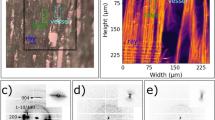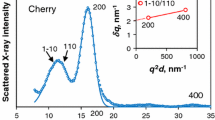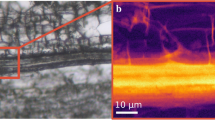Abstract
The microfibril angle (MFA) distribution and the size of cellulose crystallites in isolated double cell walls of Norway spruce (Picea abies [L.] Karst.) tracheids were determined by synchrotron X-ray microdiffraction using the reflections 200 and 004. Samples were 25 μm thick longitudinal sections of earlywood from annual rings 6–18 of several stems. The asymmetric MFA distributions extended from −20° to 90°. The mean MFA of tangential cell walls decreased from an average of 24° into 19° from the pith to the bark. The mode of the MFA distribution was about 10° smaller than the mean MFA. The standard deviation of the MFA distribution varied between 18° and 25°. The mean MFA and the mode of the MFA distribution were larger in radial than in tangential cell walls. MFA distributions of mature wood samples exhibited a separate small peak at around 90°. The average width and length of cellulose crystallites varied between 28.9–30.9 Å and 192–284 Å, respectively. Both increased slightly as a function of annual ring number from the pith up to the 15th annual ring. An irrigation–fertilisation treatment of some of the stems resulted in longer cellulose crystallites compared to the untreated stems.





Similar content being viewed by others
References
Abe H, Funada R (2005) Review: The orientation of cellulose microfibrils in the cell walls of tracheids in conifers. IAWA J 26:161–174
Abe H, Ohtani J, Fukazawa K (1991) FE-SEM observations on the microfibrillar orientation in the secondary wall of tracheids. IAWA Bull 12:431–438
Abe H, Ohtani J, Fukazawa K (1992) Microfibrillar orientation of the innermost surface of conifer tracheid walls. IAWA Bull 13:411–417
Abe H, Funada R, Imaizumi H, Ohtani J, Fukazawa K (1995) Dynamic changes in the arrangement of cortical microtubules in conifer tracheids during differentiation. Planta 197:418–421
Abe K, Yamamoto H (2005) Mechanical interaction between cellulose microfibril and matrix substance in wood cell wall determined by X-ray diffraction. J Wood Sci 51:334–338
Anagnost SE, Mark RE, Hanna RB (2000) Utilization of soft-rot cavity orientation for the determination of microfibril angle. Part I. Wood Fiber Sci 32:81–87
Andersson S, Serimaa R, Torkkeli M, Paakkari T, Saranpää P, Pesonen E (2000) Microfibril angle of Norway spruce [Picea abies (L.) Karst.] compression wood: comparison of different measuring techniques. J Wood Sci 46:343–349
Andersson S, Serimaa R, Paakkari T, Saranpää P, Pesonen E (2003) Crystallinity of wood and the size of cellulose crystallites in Norway spruce (Picea abies). J Wood Sci 49:531–537
Andersson S, Serimaa R, Väänänen T, Paakkari T, Jämsä S, Viitaniemi P (2005) X-ray scattering studies of thermally modified Scots pine (Pinus sylvestris [L.]). Holzforschung 59:422–427
Astley RJ, Stol KA, Harrington JJ (1998) Modelling the elastic properties of softwood. Part II: The cellular microstructure. Holz Roh- Werkst 56:43–50
Bailey IW, Vestal MR (1937) The orientation of cellulose in the secondary wall of tracheary cells. J Arnold Arbor 18:185–195
Baskin TI (2001) On the alignment of cellulose microfibrils by cortical microtubules: a review and a model. Protoplasma 215:150–171
Batchelor WJ, Conn AB, Parker IH (1997) Measuring the fibril angle of fibres using confocal microscopy. Appita J 50:377–380
Bergander A, Salmén L (2002) Cell wall properties and their effects on the mechanical properties of fibers. J Mater Sci 37:151–156
Booker RE, Sell J (1998) The nanostructure of the cell wall of softwoods and its functions in a living tree. Holz Roh- Werkst 56:1–8
Bowling AJ, Amano Y, Lindstrom R, Brown RM Jr (2001) Rotation of cellulose ribbons during degradation with fungal cellulose. Cellulose 8:91–97
Brown RM Jr (1996) The biosynthesis of cellulose. J Macromol Sci Pure Appl Chem A 33:1345–1373
Brändström J, Bardage SL, Daniel G, Nilsson T (2003) The structural organisation of the S-1 cell wall layer of Norway spruce tracheids. IAWA J 24:27–40
Butterfield BG (ed) (1998) Microfibril Angle in wood, the proceeding of the IAWA/IUFRO international workshop on the significance of Microfibril Angle to wood quality. University of Canterbury Press, Christchurch
Cave ID (1966) Theory of X-ray measurement of microfibril angle in wood. Forest Prod J 16:37–42
Cave ID, Hutt L (1969) The longitudinal Young’s modulus of Pinus Radiata. Wood Sci Technol 3:40–48
Cave ID, Walker JCF (1994) Stiffness of wood in fast-grown plantation softwoods: the influence of microfibril angle. Forest Prod J 44:43–48
Cosgrove DJ (2005) Growth of the plant cell wall. Nat Rev Mol Cell Biol 6:850–861
Cousins WJ (1972) Measurement of mean microfibril angles of wood tracheids. Wood Sci Technol 6:58
Delmer DP (1999) Cellulose biosynthesis: exciting times for a difficult field of study. Annu Rev Plant Physiol Plant Mol Biol 50:245–276
Donaldson LA (1991) The use of pit apertures as windows to measure microfibril angle in chemical pulp fibers. Wood Fiber Sci 23:290–295
Donaldson LA, Xu P (2005) Microfibril orientation across the secondary cell wall of Radiata pine tracheids. Trees 19:644–653
Emons AMC, Mulder BM (1998) The making of the architecture of the plant cell wall: How cells exploit geometry. Proc Natl Acad Sci USA 95:7215–7219
Evans R (1999) A variance approach to the X-ray diffractometric estimation of microfibril angle in wood. Appita J 52:283–294
Fengel D, Wegener G (1984) Wood: chemistry, ultrastructure, reactions. Walter de Gruyter, New York
Gorisek Z, Torelli N (1999) Microfibril angle in juvenile, adult and compression wood of spruce and silver fir. Phyton-Ann Rei Bot 39:129–132
Guitard D, Masse H, Yamamoto H, Okuyama T (1999) Growth stress generation: a new mechanical model of the dimensional change of wood cells during maturation. J Wood Sci 45:384–391
Hanley SJ, Revol J-F, Godbout L, Gray DG (1997) Atomic force microscopy and transmission electron microscopy of cellulose from Micrasterias denticulata; evidence for a chiral helical microfibril twist. Cellulose 4:209–220
Himmelspach R, Williamson RE, Wasteneys GO (2003) Cellulose microfibril arrangement recovers from DCB-induced disruption despite microtubule disorganization. Plant J 36:565–575
Hori R, Müller M, Watanabe U, Lichtenegger HC, Fratzl P, Sugiyama J (2002) The importance of seasonal differences in the cellulose microfibril angle in softwoods in determining acoustic properties. J Mater Sci 37:4279–4284
Jahan MS, Mun SP (2005) Effect of tree age on the cellulose structure of Nalita wood (Trema orientalis). Wood Sci Technol 39:367–373
Khalili S, Nilsson T, Daniel G (2001) The use of soft rot fungi for determining the microfibrillar orientation in the S2 layer of pine tracheids. Holz Roh- Werkst 58:439–447
Koponen S, Toratti T, Kanerva P (1989) Modelling longitudinal elastic and shrinkage properties of wood. Wood Sci Technol 23:55–63
Koponen T, Karppinen T, Hæggström E, Saranpää P, Serimaa R (2005) The stiffness modulus in Norway spruce as a function of year ring. Holzforschung 59:451–455
Lichtenegger H, Müller M, Paris O, Riekel C, Fratzl P (1999a) Imaging of the helical arrangement of cellulose fibrils in wood by synchrotron X-ray microdiffraction. J Appl Cryst 32:1127–1133
Lichtenegger H, Reiterer A, Stanzl-Tschegg SE, Fratzl P (1999b) Cellulose microfibril angles in softwoods and hardwoods—a possible strategy of mechanical optimization. J Struct Biol 128:257–269
Lichtenegger H, Reiterer A, Tschegg SE, Müller M, Riekel C, Paris O, Fratzl P (2000) Microfibril angle and mechanical properties of wood. In: Spatz HC, Speck T (eds) Proceedings of the 3rd plant biomechanics conference. Georg Thieme, Stuttgart, New York, pp 436–442
Lichtenegger HC, Müller M, Wimmer R, Fratzl P (2003) Microfibril angles inside and outside crossfields of Norway spruce tracheids. Holzforschung 57:13–20
Linder S (1995) Foliar analysis for detecting and correcting nutrient imbalances in Norway spruce. Ecol Bull 44:178–190
Lindstrom H, Evans JW, Verrill SP (1998) Influence of cambial age and growth conditions on microfibril angle in young Norway spruce (Picea abies [L.] Karst.). Holzforschung 52:573–581
Manwiller FG (1966) Senarmont compensation for determining fibril angles of cell wall layers. Forest Prod J 16:26–30
Marton R, Rushton P, Sacco JS, Sumiya K (1972) Dimensions and ultrastructure in growing fibers. Tappi 55:1499–1504
Matthews JF, Skopec CE, Mason PE, Zuccato P, Torget RW, Sugiyama J, Himmel ME, Brady JW (2006) Computer simulation studies of microcrystalline cellulose Iβ. Carbohydr Res 341:138–152
Mott L, Shaler M, Groom LH (1996) A technique to measure strain distributions in single wood pulp fibers. Wood Fiber Sci 28:429–437
Mulder BM, Emons AMC (2001) A dynamical model for plant cell wall architecture formation. J Math Biol 42:261–289
Müller M, Hori R, Itoh T, Sugiyama J (2002) X-ray microbeam and electron diffraction experiments on developing xylem walls. Biomacromolecules 3:182–186
Müller M, Burghammer M, Sugiyama J (2006) Direct investigation of the structural properties of tension wood cellulose microfibrils using microbeam X-ray fibre diffraction. Holzforschung 60:474–479
Nishiyama Y, Langan P, Chanzy H (2002) Crystal structure and hydrogen-bonding system in cellulose Iβ from synchrotron X-ray and neutron fiber diffraction. J Am Chem Soc 124:9074–9082
Nishiyama Y, Kim U-J, Kim D-Y, Katsumata KS, May RP, Langan P (2003) Periodic disorder along ramie cellulose microfibrils. Biomacromolecules 4:1013–1017
Paakkari T, Serimaa R (1984) A study of the structure of wood cells by X-ray diffraction. Wood Sci Technol 18:79–85
Page DH (1969) A method for determining the fibrillar angle in wood tracheids. J Microsci 90:137–143
Page DH, El-Hosseiny F, Winkler K, Lancaster APS (1977) Elastic modulus of single wood pulp fibers. Tappi 60:114–117
Panshin AJ, Zeeuw C de (1980) Textbook of wood technology, 4th edn. McGraw-Hill Inc., New York
Paredez AR, Somerville CR, Ehrhardt DW (2006) Visualisation of cellulose synthase demonstrates functional association with microtubules. Science 312:1491–1495
Persson K (2000) Micromechanical modelling of wood and fibre properties. PhD Thesis, Lund University, Sweden
Perämäki M, Nikinmaa E, Sevanto S, Ilvesniemi H, Siivola E, Hari P, Vesala T (2001) Tree stem diameter variations and transpiration in Scots pine: an analysis using a dynamic sap flow model. Tree Phys 21:889–897
Peura M, Müller M, Serimaa R, Vainio U, Sarén M-P, Saranpää P, Burghammer M (2005) Structural studies of single wood cell walls by synchrotron X-ray microdiffraction and polarised light microscopy. Nucl Inst Meth B 238:16–20
Peura M, Grotkopp I, Lemke H, Vikkula A, Laine J, Müller M, Serimaa R (2006) Negative Poisson ratio of crystalline cellulose in kraft cooked Norway spruce. Biomacromolecules 7:1521–1528
Peura M, Kölln K, Grotkopp I, Saranpää P, Müller M, Serimaa R (2007) The effect of axial strain on crystalline cellulose in Norway spruce. Wood Sci Technol doi: 10.1007/s00226-007-0141-x
Preston RD (1934) The organization of the cell wall of the conifer tracheid. Philos Trans R Soc B 224:131–173
Preston RD (1945) The fine structure of the wall of the conifer tracheid. I: The X-ray diagram of conifer wood. Proc R Soc B 133:327–348
Preston RD (1946) The fine structure of the wall of the conifer tracheid. II: Optical properties of dissected walls of Pinus insignis. Proc R Soc B 134:202–218
Reiterer A, Lichtenegger H, Tschegg S, Fratzl P (1999) Experimental evidence for a mechanical function of the cellulose microfibril angle in wood cell walls. Phil Mag A 79:2173–2184
Reiterer A, Lichtenegger H, Fratzl P, Stanzl-Tschegg SE (2001) Deformation and energy absorption of wood cell walls with different nanostructure under tensile loading. J Mater Sci 36:4681–4686
Riekel C (2000) New avenues in X-ray microbeam experiments. Rep Progr Phys 63:233–262
Roberts AW, Frost AO, Roberts EM, Haigler CH (2004) Roles of microtubules and cellulose microfibril assembly in the localization of secondary cell-wall deposition in developing tracheary elements. Protoplasma 224:217–229
Salmén L (2004) Micromechanical understanding of the cell-wall structure. C R Biol 327:873–880
Sarén M-P, Serimaa R, Andersson S, Paakkari T, Saranpää P, Pesonen E (2001) Structural variation of tracheids in Norway spruce (Picea abies [L.] Karst.). J Struct Biol 136:101–109
Sarén M-P, Serimaa R, Andersson S, Saranpää P, Keckes J, Fratzl P (2004) Effect of growth rate on mean microfibril angle and cross-sectional shape of tracheids of Norway spruce. Trees 18:354–362
Sarén M-P, Peura M, Serimaa R (2005) Interpretation of microfibril angle distributions in wood using microdiffraction experiments on single cells. J X-ray Sci Tech 13:191–197
Sarén M-P, Serimaa R (2005) Determination of microfibril angle distribution by X-ray diffraction. Wood Sci Technol 40:445–460
Schmitt U, Ander P, Barnett JR, Emons AMC, Jeronimidis G, Saranpää P, Tschegg S (eds) (2004) Wood fibre cell walls: methods to study their formation, structure and properties. Swedish University of Agricultural Sciences, Uppsala
Sedighi-Gilani M, Sunderland H, Navi P (2006) Within-fiber nonuniformities of microfibril angle. Wood Fiber Sci 38:132–138
Senft JF, Bendtsen BA (1985) Measuring microfibrillar angles using light microscopy. Wood Fiber Sci 17:564–567
Sobue N, Shibata Y, Mizusawa T (1992) X-ray measurement of lattice strain of cellulose crystals during the shrinkage of wood in the longitudinal direction. Mokuzai Gakkaishi 38:336–341
Sugiyama J, Vuong R, Chanzy H (1991) Electron diffraction study on the two crystalline phases occurring in native cellulose from an algal cell wall. Macromolecules 24:4168–4175
Tejada A, Okuyama T, Yamamoto H, Yoshida M (1997) Reduction of growth stress in logs by direct heat treatment: assessment of a commercial-scale operation. For Prod J 47:86–93
Vainio U, Andersson S, Serimaa R, Paakkari T, Saranpää P, Treacy M, Evertsen J (2002) Variation of microfibril angle between four provenances of Sitka spruce (Picea sitchensis [Bong.] Carr.). Plant Biol 4:27–33
Wardrop AB, Harada H (1965) The formation and structure of the cell wall in fibres and tracheids. J Exp Bot 16:356–371
Wasteneys GO (2004) Progress in understanding the role of microtubules in plant cells. Curr Opin Plant Biol 7:651–660
Wymer C, Lloyd C (1996) Dynamic microtubules: implications for cell wall patterns. Trends Plant Sci 1:222–228
Yamamoto H, Okuyama T, Yoshida M (1995) Generation process of growth stresses in cell walls VI. Analysis of growth stress generation by using a cell model having three layers (S1, S2, and I + P). Mokuzai Gakkaishi 41:1–8
Yamamoto H (1998) Generation mechanism of growth stresses in wood cell walls: roles of lignin deposition and cellulose microfibril during cell wall maturation. Wood Sci Technol 32:171–182
Yamamoto H, Kojima Y (2002) Properties of cell wall constituents in relation to longitudinal elasticity of wood. Part 1. Formulation of the longitudinal elasticity of an isolated wood fiber. Wood Sci Technol 36:55–74
Zweifel R, Item H, Häsler R (2001) Link between diurnal stem radius changes and tree water relations. Tree Phys 21:869–877
Acknowledgments
The authors wish to thank the European Synchrotron Radiation Facility (ESRF) for allocating the necessary experiment time for our study. Dr. Manfred Burghammer and Dr. Christian Riekel of ESRF are gratefully acknowledged for their assistance during the measurements at ID 13. The authors are grateful to Professor Sune Linder (SLU, Sweden) for allowing the material from Flakaliden to be used in this experiment and to Dr. Harri Mäkinen of the Finnish Forest Research Institute for providing information on the widths of the annual rings in the stems used in this study. The Academy of Finland is gratefully acknowledged for financing (grant number 104837).
Author information
Authors and Affiliations
Corresponding authors
Additional information
Communicated by T. Hogetsu.
Rights and permissions
About this article
Cite this article
Peura, M., Müller, M., Vainio, U. et al. X-ray microdiffraction reveals the orientation of cellulose microfibrils and the size of cellulose crystallites in single Norway spruce tracheids. Trees 22, 49–61 (2008). https://doi.org/10.1007/s00468-007-0168-5
Received:
Revised:
Accepted:
Published:
Issue Date:
DOI: https://doi.org/10.1007/s00468-007-0168-5




